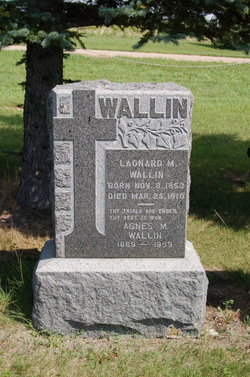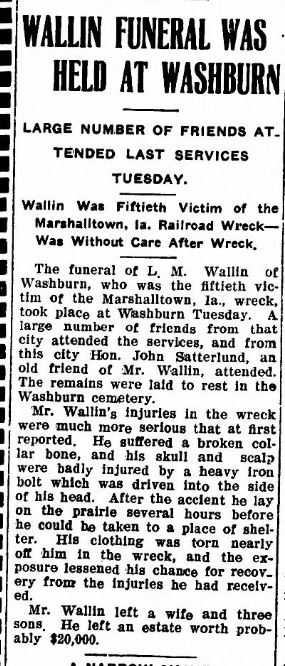On Sunday, March 20, 1910 (Palm Sunday) the collapse of a railroad bridge under the weight of a freight train, set off a string of events that would culminate in the worst passenger train disaster in Iowa history. Known variously as the Green Mountain Train Wreck or the “Wreck of the Rock”, the event left an indelible mark on Central Iowa.
The collapse of the bridge near Shellsburg, Iowa caused the freight train to derail and plunge into the creek below.
That same day, two Rock Island passenger trains, one coming from Chicago and one from St. Louis, were prevented from traveling on to their destination of Minneapolis by the closure of the rail line near Shellsburg. Eventually, the Rock Island line was given permission by railroad officials to detour the trains to Marshalltown and then travel on to Waterloo where they were to continue their trip to Minneapolis via Rock Island tracks.
The second of the two trains reached Marshalltown in the early hours of Monday, March 21st. After some strategizing by rail officials, a decision was made to join the two trains together for the 40 some mile trip to Waterloo. However, two problems stood in the way; both trains came to Marshalltown from the East and thus were headed the wrong direction for the trip to Waterloo, and the rail yards in Marshalltown had neither a turntable nor a “Y” of sufficient size to turn the locomotives.
The combined train was placed under the direction of “pilot” John White of Des Moines. Mr. White made the decision to back the locomotives all the way to Waterloo and then turn them around for the trip to Minneapolis once they reached Waterloo’s rail yard. In addition, he decided to arrange the combined train with the reversed engines preceded by their own coal-tenders and the wooden passenger cars of the St Louis train followed by the steel Pullman cars of the Chicago train.
The decision to combine the cars in this order and back the engines violated two very important railroad safety rules of the time; backed steam engines were to operate no faster than 10-15 miles per hour and the heavier steel Pullman cars were always to precede lighter wooden cars. Although rail officials to this day have never released a definitive finding as to the speed of the train at the time of the derailment, deciding to back the engines of an already very delayed train made it highly unlikely that the crew would be able to follow the safety constraint of keeping the speed under 15 mph.
At a place between Green Mountain and Gladbrook just east of the Marshall County border the lead engine left the tracks and hit a clay embankment coming to a sudden stop. The steel cars sliced through the two wooden coaches: a smoking car and a ladies' day coach containing many children. There were no fatalities in the Pullman cars; one of the uninjured passengers said "I saw women in the coach crushed into a bleeding mass, their bodies twisted out of human shape. I have seen what I shall see all my life when I dream". A relief train arrived two hours after the accident "The sight was one of horribly crushed, mutilated, and dismembered bodies".
No official cause was ever released for the wreck, nor were any charges of neglect made although the crash did result in the introduction of new safety procedures.
On Sunday, March 20, 1910 (Palm Sunday) the collapse of a railroad bridge under the weight of a freight train, set off a string of events that would culminate in the worst passenger train disaster in Iowa history. Known variously as the Green Mountain Train Wreck or the “Wreck of the Rock”, the event left an indelible mark on Central Iowa.
The collapse of the bridge near Shellsburg, Iowa caused the freight train to derail and plunge into the creek below.
That same day, two Rock Island passenger trains, one coming from Chicago and one from St. Louis, were prevented from traveling on to their destination of Minneapolis by the closure of the rail line near Shellsburg. Eventually, the Rock Island line was given permission by railroad officials to detour the trains to Marshalltown and then travel on to Waterloo where they were to continue their trip to Minneapolis via Rock Island tracks.
The second of the two trains reached Marshalltown in the early hours of Monday, March 21st. After some strategizing by rail officials, a decision was made to join the two trains together for the 40 some mile trip to Waterloo. However, two problems stood in the way; both trains came to Marshalltown from the East and thus were headed the wrong direction for the trip to Waterloo, and the rail yards in Marshalltown had neither a turntable nor a “Y” of sufficient size to turn the locomotives.
The combined train was placed under the direction of “pilot” John White of Des Moines. Mr. White made the decision to back the locomotives all the way to Waterloo and then turn them around for the trip to Minneapolis once they reached Waterloo’s rail yard. In addition, he decided to arrange the combined train with the reversed engines preceded by their own coal-tenders and the wooden passenger cars of the St Louis train followed by the steel Pullman cars of the Chicago train.
The decision to combine the cars in this order and back the engines violated two very important railroad safety rules of the time; backed steam engines were to operate no faster than 10-15 miles per hour and the heavier steel Pullman cars were always to precede lighter wooden cars. Although rail officials to this day have never released a definitive finding as to the speed of the train at the time of the derailment, deciding to back the engines of an already very delayed train made it highly unlikely that the crew would be able to follow the safety constraint of keeping the speed under 15 mph.
At a place between Green Mountain and Gladbrook just east of the Marshall County border the lead engine left the tracks and hit a clay embankment coming to a sudden stop. The steel cars sliced through the two wooden coaches: a smoking car and a ladies' day coach containing many children. There were no fatalities in the Pullman cars; one of the uninjured passengers said "I saw women in the coach crushed into a bleeding mass, their bodies twisted out of human shape. I have seen what I shall see all my life when I dream". A relief train arrived two hours after the accident "The sight was one of horribly crushed, mutilated, and dismembered bodies".
No official cause was ever released for the wreck, nor were any charges of neglect made although the crash did result in the introduction of new safety procedures.
Inscription
THY TRIALS ARE ENDED
THY REST IS WON
Gravesite Details
Son of Magnus and Caroline Johansen Wallin
Family Members
Sponsored by Ancestry
Advertisement
Advertisement







